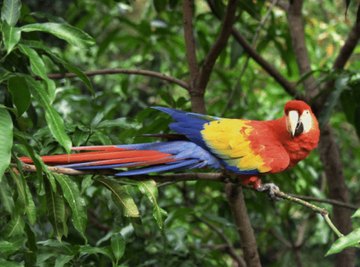
The tropical rain forest is one of several major biomes, or ecoregions, on planet Earth. Others include temperate forests, deserts, grasslands and tundra. Each biome has a distinct set of environmental conditions to which animals are adapted.
Evolution
Animal adaptations occur through the process of evolution. Successive generations of animals change in response to environmental conditions through the process of natural selection. Evolution is a process by which, over long periods of time, a particular kind of life form can develop into an entirely new species. During the course of this change many smaller adaptations can occur, and these contribute to overall evolution.
Process or Characteristic
Adaptation can be a process or a characteristic. A set or series of relatively small changes that add up, over time, can result in a major evolutionary change. Some of these small changes are adaptations. That is the process of adaptation. The result of the process -- on the other hand -- is a characteristic or physical feature, also called an adaptation.
An example is the emerald tree boa. It is native to the tropical rain forests of South America. The emerald tree boa is adapted to life in the trees. One conspicuous adaptation is the boa’s color, which helps to conceal it in the rainforest canopy. The boa’s front teeth are extra long, an adaption the facilitates capturing its prey.
Past
Paleontologists are scientists who study ancient or extinct life forms. A large part of their work is focused on fossil evidence. Through studying the fossil record, paleontologists can discover and track animal adaptations as they have occurred through prehistory. Parts of the earth that are now temperate forest or other biomes once had thriving tropical rainforests. An example of an animal adapted to life in the tropical rain forest is the crocodile. While some lines of evolution indicate that animals have changed and adapted dramatically into different forms, the crocodile is evidently so well adapted that it has changed very little over many millions of years.
Future
As scientists understand evolution, it is a continuous process, so there is not necessarily a final set of adaptations. Scientists expect virtually every animal in the tropical rainforest to continue to evolve and develop new adaptations to changing environmental conditions in the future. Although scientists may be able to make some predictions about the future, the future has no means of direct study or observation. Future adaptations of animals in the tropical rain forest, therefore, are a matter of speculation.
References
About the Author
Donald Miller has a background in natural history, environmental work and conservation. His writing credits include feature articles in major national print magazines and newspapers, including "American Forests" and a nature column for "Boys' Life Magazine." Miller holds a Bachelor of Science in natural resources conservation.
Photo Credits
NA/Photos.com/Getty Images
